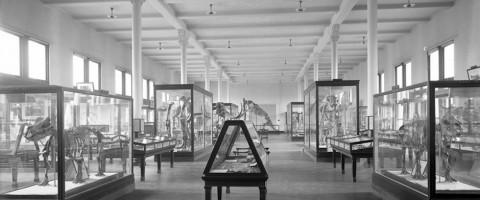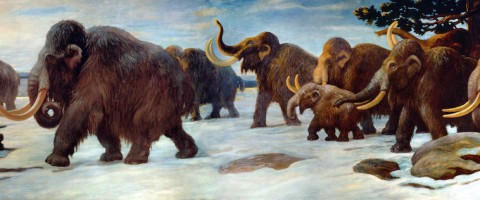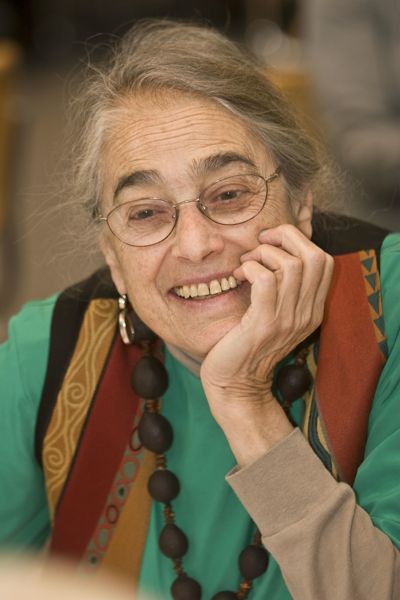 Evelyn Fox Keller is a theoretical physicist, a mathematical biologist, a feminist philosopher, and a historian of science. Throughout her career she has pushed the boundaries of science, confidently crossing the borders that separate disciplines and breaking down the barriers keeping women out of the highest reaches of scientific achievement. Her work has been hugely influential to me, and I was thrilled to have the opportunity to discuss her career with her over the course of several conversations in her Cambridge, Massachusetts home. The following is a heavily edited transcript of our exchange, woven through with excerpts of Keller’s writings from different stages of her prolific career.
Evelyn Fox Keller is a theoretical physicist, a mathematical biologist, a feminist philosopher, and a historian of science. Throughout her career she has pushed the boundaries of science, confidently crossing the borders that separate disciplines and breaking down the barriers keeping women out of the highest reaches of scientific achievement. Her work has been hugely influential to me, and I was thrilled to have the opportunity to discuss her career with her over the course of several conversations in her Cambridge, Massachusetts home. The following is a heavily edited transcript of our exchange, woven through with excerpts of Keller’s writings from different stages of her prolific career.
Even a curriculum vitae is a kind of autobiography. Rudimentary and transparent though it is, it may reveal deeply personal traits. Certainly my own does; it makes abundantly clear that I have something of a problem with borders: in my peculiar psychic and intellectual economy borders are meant for crossing. More, they constitute irresistible lures. I seek them out — not to test their limits but to worry them, as a dog does a bone. Even as a working scientist, I found it hard to stay put, to keep from straying back and forth — in those days between biology and physics, between theory and experiment. And once I strayed beyond the borders of research science, shifted from doing science to writing about it, the problem only grew worse, for now I had many more boundaries to worry.”
-Preface to Refiguring Life: Metaphors of Twentieth-century Biology (1995)
Border Crossings
Mostly when I think about border crossings I think about my extra-scientific career. But it is true that within the sciences I crossed many borders. When we talk about my career — it’s a thicket. It was a thicket from the get-go.
First I should say, we came from a rather poor, working class family. My parents were both immigrants. I had a brother and sister, both older than me. My sister went off to college when she was not quite sixteen, so when I was twelve and a half. When she came home after her first semester she told me about the unconscious — I thought that was the best idea I had ever heard! I decided then and there that I wanted to be a psychoanalyst. At the same time, my brother thought I was really smart and therefore should become a scientist like him. He was constantly trying to interest me in science, giving me all these books to read. But I had no interest in science, I wanted to be a psychoanalyst! I loved to read, I read all these novels, but I didn’t read the books he gave me.
Eventually I went to Queens College and I declared my major as psychology. But I took calculus, I was going to study math no matter what because I liked it, but it had nothing to do with my career. The calculus class met in this huge room with maybe 100 students, and was taught by Banesh Hoffman, who had worked with Einstein.
Here he is greeting his new class, and as he greets every new class, he starts out with a series of trick questions. I’m a New York City kid so I raise my hand and I know all the answers. So he calls me up after class. His first question is, “Are you related to Maurice Fox?” Can you imagine, this man is teaching four courses a semester, processing all these kids through calculus and he remembers my brother from 11 years ago?
Anyway, I said “Yes.”
He says, “What are you majoring in?”
“Psychology.”
“Why not mathematics?”
“I don’t want to be an accountant.”
He says, “What about physics?”
and I said, “What’s that?” That was the end of the first conversation.
That same semester I was taking freshman composition and doing terribly. I couldn’t get better than a C+. Finally I decided that for one assignment I should do a book review on one of the books my brother had given me. It turns out they were really interesting! One was about relativity and one was about quantum mechanics. I got A’s on the reports.
After that I remember going to a party with all these literature majors and someone asked, “What are you majoring in?” and I said, “Maybe I’ll major in physics, it’s neat, and it gets me A’s.”
He says, “You can’t do that, you’re a girl!”
I said, “Oh yeah??” That was all I needed. I mean what the hell, I’ll major in physics and then I’ll be a psychoanalyst. That was my plan.
“You can’t do that, you’re a girl!”
The Anomaly of a Woman
After I transferred to Brandeis I took one of my first physics courses with Sam Schweber. He came into the room, he turned his back, and he started writing on the board. To me it looked like it was in Arabic, some sort of script, some signs and language I didn’t know. I dutifully copied them down not knowing, not having clues to what they meant, and spending the weekends taking books home from the library, trying to find what those squiggles meant. It was like a hermeneutic exercise. I was totally engaged. By that summer I had figured out quite a lot.
The second year I’m taking a course in theoretical physics. The third year is my senior year, I do a senior thesis on Feynman’s Lagrangian formulation of quantum mechanics. I went fast! And I still had no idea what physics was about. I had no idea—it was to me a formalism. it was like studying a very opaque obscure religious text, and I loved it! What I got from that was the idea that you could deduce, just by thinking, you could deduce the way the world is. I could think about questions like, Why is space three dimensional? There were kinds of answers you could come up with, just with thinking in theoretical formal terms.
But it was all very other-worldly; it had nothing to do with the concrete world in which we live. I was totally intoxicated by these ideas, thinking worlds into being, out of pure thought. By my senior year, I thought, Well maybe I should study physics, really study physics. Because it was so interesting, I had been so blown away by this idea of thinking the world into being. I decided to go to graduate school and Sam told me, “You have to go to Harvard.”
It was really a mistake—a bad, bad mistake. Have you read my essay on being a graduate student at Harvard? I won’t even talk about it, it was a nightmare. Nobody would talk to me. And I didn’t know what to do.
The story of my graduate school experience is a difficult one to tell. It is difficult in part because it is a story of behavior so crude and so extreme as to seem implausible.
Moreover, it is difficult to tell because it is painful. In the past, the telling of this story always left me so badly shaken, feeling so exposed, that I became reluctant to tell it. Many years have passed, and I might well bury those painful recollections. I do not because they represent a piece of reality—an ongoing reality that affects others, particularly women. Even though my experiences may have been unique–no one else will share exactly these experiences—the motives underlying the behavior I am going to describe are, I believe, much more prevalent than one might think, and detectable in fact in behavior much less extreme…
Sometimes I was queried about my peculiar ambition to be a theoretical physicist—didn’t I know that no woman at Harvard had ever so succeeded (at least not in becoming a pure theoretical physicist)? When would I too despair, fail, or go elsewhere (the equivalent of failing)?
The summer after my first year my brother was going to Cold Spring Harbor and there was a spare bed in the baby’s room where he was staying. I could come and spend the summer in Cold Spring Harbor and figure out what I was going to do. I arranged it so that I could keep getting my graduate student stipend: I did a reading course on interpretations of quantum mechanics. I packed a suitcase full of Freud, and went to Cold Spring Harbor.
So there I had the quantum mechanics, the psychoanalysis in my suitcase, and there I was at the birth of molecular biology. There were all these young guys who were just going to remake the world. It was so interesting; I got seduced and brought into the lab. I was working with Frank Stahl and Max Delbrück—everyone was trying to lure me into molecular biology. That was the time! I was young, I was attractive, I was smart, and they were all looking for new recruits. I was hot.
In Frank’s lab I discovered a phenomenon. It was a very simple idea, but I recognized its power and that was really something. We didn’t know the genetic code yet, and I recognized a way that we could use a chemical variant of DNA to answer the question of whether one or both strands were coding for proteins. What about the complementary strand, is that coding for the same protein, or is it not read? I could do this for a thesis and I could do it in three months—it was easy! Biology was so easy! It didn’t turn out that way of course, but that’s what got me into it.
The Question of Gender
I remember a time when I was talking with one of the professors in the physics department, before I switched to molecular biology. He had been friendly, and I remember getting a ride home with him from a seminar at MIT, and he asked “How’s it going?” and I started to tell him about how no one would talk to me—everything that eventually became “The Anomaly of a Woman in Physics.” I tell him and he looks at me as if I’d just committed a terrible faux pas. I opened the car door and I walked out.
I didn’t talk about it after that—at least not until 1970, when I was invited to give a series of talks about mathematical biology at the University of Maryland. I decided that I couldn’t in good conscience give five lectures on my work in mathematical biology and never mention the fact of being a woman. So I write up four talks on mathematical biology and for last talk, I talk about women in science.
In that talk, I didn’t just talk about my own experiences. In the few years before that, I had started thinking about why there are so few women in science overall and I had started collecting data. I started out this lecture with an equation—a birth and death equation—and I showed the statistics I had gathered about how the percentage of women drops off dramatically throughout the academic ladder and I asked, What is killing them off?
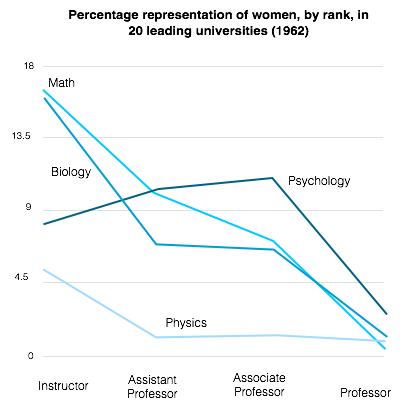
The rest of the lecture was a review of all the barriers that operate for women in science. In the end I concluded that probably the most important factor is the widespread belief in the intrinsic masculinity of science. What is that belief doing in science? And what effects does it have? First, on women who try to be scientists, and second, on the science. We’re not talking about the influence of sex on the science, we’re talking about the belief. We’re talking about gender as an ideology.
I wrote up that talk and published it in Harvard Magazine, and shortly after that I published “The Anomaly of a Woman in Physics.” I remember after that was published getting on an elevator packed with men, male scientists, and one female colleague. She said, “Oh Evelyn, how does it feel to go naked in public?”
“How does it feel to go naked in public?”
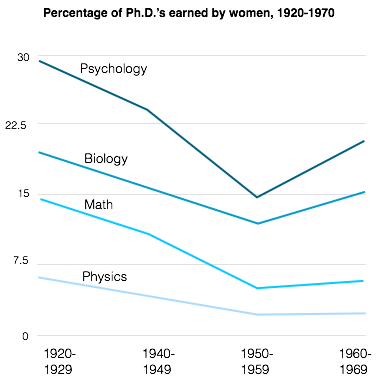
At that time it was a taboo subject. Actually, if you look at the history of women in science, women in science in the first part of the century were doing relatively well. The real dive came with World War II and it coincided with the strategy of removing their first names. Because they didn’t want attention called to them as being women—because they wanted to be just neutral—they took their names off. There were multiple times when I tried to talk to people who had written or spoken about my work but they would ignore me, not realizing that I was EF Keller and that I was a woman!
We are speaking of course of the problem that inheres in the fact that the universal standard is after all not neutral—of what happens to our strategy, and our thinking about gender and science when we begin to notice that the universal man is, in fact, male. The first thing this recognition enables us to do is to begin to make sense of the failure of the promise of equity. To be included in the big “one” means not to be equally represented, but to be unrepresented. It is to be swallowed up whole, negated in the quest for assimilation—as it were, a hole in “one”.
-“How Gender Matters, or, Why It’s so hard for Us to Count Past Two”, in Perspectives on Gender and Science, ed. Jan Harding (1986).
Stereotypes are Never Idle
When people would ask me what I was working on, I’d say, “Gender and science.”
And they’d say, “What is it you’ve learned about women in science?”
“I haven’t learned anything about women in science—if anything I’m writing about men in science and their beliefs!”
But nobody got it, and everyone kept insisting I was writing about women being genetically different, or women doing a different kind of science. No! I was writing about doing science in a gendered world. This was very frustrating, because the collapse of my argument from gender to women made my argument very different—politically as well as conceptually. It made it seem like I was making an argument for women not belonging in science, because if science is masculine then women don’t belong there. I was very sensitive to that.
(Because confusion is so easy here, let me make it absolutely clear that this is not an argument for duality—for a female science either to replace or supplement a male science. That is, I do not believe that science is written in our chromosomes—neither in the X nor the Y chromosome)…
The relationship between gender and science is a pressing issue not simply because women have been historically excluded from science, but because of the deep interpenetration between our cultural construction of gender, and our naming of science. The same cultural tradition that names rational, objective, and transcendent as male, and irrational, subjective, and immanent as female, also, and simultaneously, names the scientific mind as male, and material nature as female…Modern science is constituted around a set of exclusionary oppositions, in which that which is named feminine is excluded, and that which is excluded—be it feeling, subjectivity, or nature—is named female. Actual human beings are of course never fully bound by stereotypes, and some men and some women—and some scientists—will always go beyond them. But at the same time, stereotypes are never idle.
-“How Gender Matters, or, Why It’s so hard for Us to Count Past Two”
Talking About Language
Much later, in the mid 80’s, I was invited to give a talk on gender and science at a colloquium that was co-sponsored by the Departments of Women’s Studies and the Physics Department. I walk in, and the room is packed. Turns out, it’s the day they award the undergraduate prize in physics, so the whole physics department was there. Big room, and it was completely filled—all men—except in the front seats, on the right, there were four or five women from Women’s Studies.
So I gulped and realized this was going to be a tough challenge! I gave my talk, and I talked about the idea of gender in science. At the end one of the physicists said, “Yeah, but you’re not talking about physics, you’re talking about language!”
That was interesting. I agreed; I was talking about how the language of science was shaped by our assumptions about gender, our model of science on gender, and the use of gendered metaphors in science. My assumption was that our metaphors and the way we talk about science affected the science we did. I was operating on the assumption that language affects the way we think and what we do, and this was the first time I realized that wasn’t obvious.
Delayed Effects
That marked a turning point from my focus on gender and science to language and science. I wrote on metaphors in evolutionary biology related to competition and reproduction, and I also wrote about developmental biology.
Developmental biology claims the interest of feminist historians of science on three different grounds: it is a field in which women have historically been relatively numerous, and in which a number of women today are leaders; in large part because of its intimate association with reproduction traces of implicit and explicit gender coding can be found in the historical structuring of the field and hence can be used to illustrate more general arguments about the symbolic work of gender in the natural sciences; and the fundamental problem of developmental biology resists resolution in terms of “master molecules” and seems to require, instead, conceptual models of just the kind that contemporary feminists have shown partiality to-that is, models of complex interactivity.
–“Developmental Biology as a Feminist Cause” (1997)
The first thing that interested me about developmental biology was that it just exploded—it burst on the scene in the early ’90s, and it made me conscious of the fact that the questions about development had been buried by the onslaught of molecular biology. The subject had originally been called embryology, but the departments of embryology through the ’40s ’50s and ’60s were dying like flies. Molecular biology had such extraordinary successes, and problems with embryology were so difficult and could claim so few dramatic successes, that the limelight just shifted away from it.
One of the main triggers in the re-emergence of developmental biology in the late ’80s and early ’90s was the work of Christiane Nüsslein-Volhard. She showed how it was possible to study the embryological development of the fruit fly.
The Drosophila embryo is a boundary object par excellence, residing in the interstices of two major disciplines, genetics and embryology. Its singular value both for the study of development per se and for its integration with the study of genetics is now widely recognized. But it was not always so. The history of Drosophila embryology exhibits not only the strengths of boundary objects in their capacity to facilitate interaction and collaboration, but also the equally obvious weaknesses that can result from their marginality.
-Drosophila Embryos as Transitional Objects (1996)
With those tools, she could understand how genes were involved in development. Before her work, the assumption was that for the life of an organism, T0 = fertilization. T final time is adulthood. So the understanding at the time was that the history of the organism begins with fertilization and ends with maturity: at fertilization, the sperm enters the egg and “activates” the genes. The sperm puts the genes into action—I’m trying to spell this out explicitly—and it triggers a chain of reactions that results in the adult. What Nüsslein-Volhard focused on with these maternal mutations were effects that were set in motion prior to fertilization: the topological map that was established in the egg prior to fertilization.
](http://www.methodquarterly.com/wp-content/uploads/2014/09/drosophila_embryo.jpg)
It was a different frame that led to a different conceptualization—not of gene action but a much more dynamic, interactive view. This was a worldview of development that was more sympathetic with feminist interests and feminist philosophy. But is it that because they were women? I didn’t think so. Is it because they were reproductive? I didn’t think so. It was outside the box, it was open, and it allowed one to look at other dimensions of the problem. That was welcome to feminists, for all kinds of reasons, but it would have been welcome to lots of other people too, who had nothing to do with feminism.
The Humility of Complexity
I think this is the most exciting time in biology, certainly in my lifetime. All kinds of assumptions that we made because they just seemed obvious are being overturned, in a way that’s very, very exciting to me. A lot of it is discovering—which has been the history since the early successes of molecular biology—more and more complexity in the system that is often beyond our capacity to make sense of. So it gives us kind of humility. It also raises some questions about what would a theory of biology look like, I mean what makes us think that we are capable of a theory of biology. Our brains are parts of biological evolution. I don’t see any reason to assume that our brains are capable theorizing the levels of complexity that biological evolution has given rise to—in our mental capacities for example.
In the early ’90s, when I had gotten interested in developmental biology and I shifted my research focus, I was just so blown away by how wonderfully complex biology had become. Compared to the way we talked about genes, it was a joke. After a particularly good series of lectures at Caltech I remember asking one of the biology professors, “Why did you leave out all the problems?”
He said, “Well it would be too complicated for a lay audience—they wouldn’t understand.”
So I resolved to talk about genetics as it was currently being addressed, in the ways that I saw, in all its complexity. I said, “I can make it understandable.”
It is a rare and wonderful moment when success teaches us humility, and this, I argue, is precisely the moment at which we find ourselves at the end of the twentieth century. Indeed, of all the benefits that genomics has bequeathed to us, this humility may ultimately prove to have been its greatest contribution. For almost fifty years, we lulled ourselves into believing that, in discovering the molecular basis of genetic information, we had found the “secret of life”; we were confident that if we could only decode the message in DNA’s sequence of nucleotides, we would understand the “program” that makes an organism what it is. And we marveled at how simple the answer seemed to be. But now, in the call for a functional genomics, we can read at least a tacit acknowledgment of how large the gap between genetic “information” and biological meaning really is.
The Century of the Gene, excerpted in the New York Times (2000)


